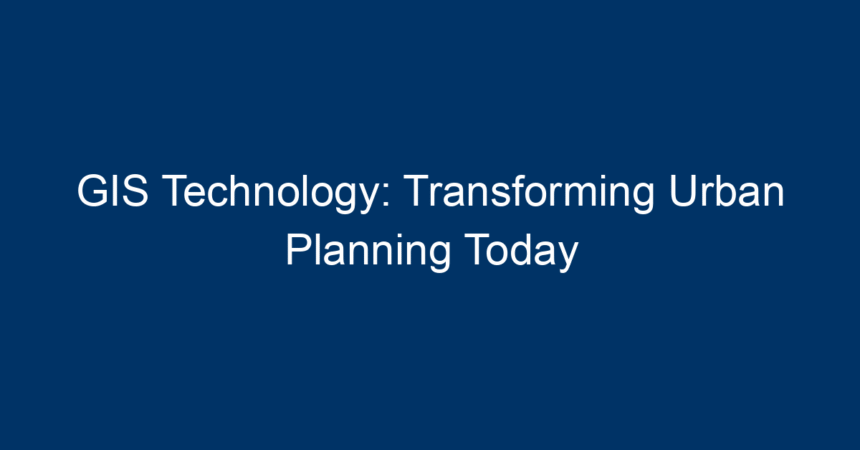Urban planning is an essential discipline that shapes the environments in which we live, work, and play. As populations grow and urban areas expand, the need for innovative solutions becomes crucial. This is where GIS technology steps in, revolutionizing the way planners approach design, management, and sustainability. Geographic Information Systems (GIS) not only enhance data visualization but also provide planners with tools to analyze trends, forecast growth, and make informed decisions.
In this article, we’ll explore how GIS technology is transforming urban planning today, detailing its applications, benefits, challenges, and future prospects.
Understanding GIS Technology
What is GIS Technology?
GIS technology refers to a suite of tools and processes that collect, manage, analyze, and visualize spatial data. Using geographic and demographic data, GIS allows urban planners to create detailed maps that show infrastructure, land use, population density, and environmental factors.
Components of GIS Technology
- Hardware: Computers and servers that store data and run software applications.
- Software: GIS applications that analyze and visualize data, such as ArcGIS and QGIS.
- Data: Geographic and attribute data that is used for mapping and spatial analysis.
- People: Skilled professionals, including urban planners, geographers, and data analysts, who interpret and utilize the data.
Key Functions of GIS Technology
- Data Layering: Combining multiple data layers to provide comprehensive analyses (e.g., socio-economic data layered over land-use maps).
- Spatial Analysis: Conducting geographic analyses to identify trends and relationships.
- Visualization: Creating maps that present complex data in accessible ways for stakeholders.
The Role of GIS Technology in Urban Planning
1. Enhancing Decision-Making Processes
One of the most significant benefits of GIS technology is its ability to support data-driven decision-making. Urban planners can visualize scenarios and outcomes based on various urban design strategies. For example, planners can analyze traffic patterns and make informed decisions about road expansions or public transport investments based on comprehensive mapping.
2. Optimizing Land Use
GIS technology enables planners to examine land-use patterns, identify underutilized areas, and strategize for future development. By overlaying demographic data with land-use maps, planners can ensure that residential, commercial, and recreational spaces are appropriately allocated.
3. Improving Public Participation
GIS technology enhances transparency and public engagement in urban planning processes. Interactive maps allow residents to visualize proposed developments and provide feedback. This fosters collaboration, encouraging community members to participate actively in planning initiatives.
4. Facilitating Environmental Sustainability
As urban areas strive for sustainability, GIS technology plays a vital role in environmental planning. Planners can assess the environmental impact of new projects, map green spaces, and identify areas prone to flooding or other ecological risks. This allows cities to build resilience against climate change and urban sprawl.
5. Emergency Management and Planning
In an era marked by natural disasters and public health crises, GIS technology is invaluable for emergency management. It allows planners to develop evacuation routes, assess risks, and coordinate responses effectively. For example, during a hurricane, GIS can provide real-time data to inform decisions about resource allocation and safe zones.
Applications of GIS Technology in Urban Planning
1. Transportation Planning
Transportation is a critical aspect of urban planning. GIS technology helps analyze current transportation networks, identify bottlenecks, and plan new roadways. By visualizing traffic patterns, planners can design public transportation routes that minimize congestion and improve accessibility.
2. Zoning and Land Use Planning
Zoning laws dictate how land can be used within a jurisdiction. GIS technology empowers planners by providing a comprehensive view of land parcels and zoning classifications. This facilitates informed decisions on rezoning requests and development applications.
3. Infrastructure Development
Infrastructure projects rely heavily on accurate data. GIS technology helps planners map existing infrastructure, identify areas for improvement, and visualize potential impacts of new developments. This ensures that infrastructure investments are made in areas of greatest need.
4. Social Services Planning
Cities must allocate resources for social services effectively. GIS technology enables planners to analyze demographic data, such as income levels and population density, to ensure equitable distribution of services like healthcare, education, and community centers.
5. Smart City Initiatives
As cities embrace the concept of "smart cities," GIS technology plays an integral role in integrating various urban systems. By connecting data from transportation, utilities, and public safety, planners can create interconnected systems that streamline operations and improve citizens’ quality of life.
Challenges Faced by GIS Technology in Urban Planning
1. Data Quality and Availability
The efficacy of GIS technology hinges on the quality and accuracy of the data used. Incomplete or outdated data can lead to misguided decisions. Urban planners must continuously update and validate their datasets to ensure reliability.
2. Technical Expertise
While GIS technology offers powerful tools, it also requires skilled personnel to interpret data effectively. The demand for professionals trained in GIS applications often outpaces availability, creating a gap in implementation.
3. Integration with Existing Systems
Integrating GIS technology with existing urban planning systems can pose challenges. Planners must ensure compatibility and streamline practices across different platforms to maximize efficiencies.
4. Budget Constraints
Urban planning initiatives may face budget limitations, affecting the ability to implement GIS technologies fully. Seeking funding and resources is crucial for cities looking to enhance their planning processes with GIS.
The Future of GIS Technology in Urban Planning
The future of GIS technology in urban planning is promising. As technology advances, we can expect to see:
- Increased Use of AI and Machine Learning: These technologies will enhance predictive analytics capabilities, allowing planners to forecast future trends with greater accuracy.
- Real-Time Data Integration: The integration of real-time data will provide planners with up-to-date information on traffic, weather, and other variables critical for decision-making.
- Public Access and Citizen Engagement: Improved platforms for citizen engagement will allow residents to interact with GIS data, fostering greater collaboration between communities and planners.
- Sustainable Development Practices: Continued focus on sustainability will lead to the integration of environmental considerations in every planning decision, supported by thoughtful spatial analyses.
Conclusion and Actionable Insights
In conclusion, GIS technology is transforming urban planning by enhancing decision-making processes, optimizing land use, and fostering community involvement. As urban areas continue to grow, the application of GIS will be essential for creating sustainable, resilient cities.
Actionable Insights for Urban Planners:
- Invest in Training: Prioritize training for staff in GIS technologies to bolster data analysis and visualization skills.
- Prioritize Data Quality: Regularly update and validate datasets to ensure reliability and accuracy in planning decisions.
- Foster Public Engagement: Utilize interactive tools to engage citizens in the planning process, making it transparent and participatory.
- Embrace New Technologies: Stay informed about advancements in GIS, AI, and data integration to leverage their potential in urban planning.
By harnessing the full capabilities of GIS technology, urban planners can build smarter, more sustainable cities for future generations.




